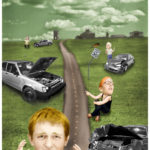Crash: A look at the frequency, locations and other factors involved in wrecks in Lawrence
Careful drivers key to safer roads

Accidents happen. In fact, thousands of traffic accidents happen every year in Lawrence.
The Journal-World and 6News analyzed all 3,106 accidents reported to Lawrence Police between June 1, 2008, and May 31, 2009, and our two-day traffic accident series beginning today examines the many factors involved in these crashes.
Accidents occur most often on the city’s busiest intersections and roadways. Iowa, 23rd, Sixth, Ninth, Tennessee and Kentucky streets account for 45 percent of all accidents in the past year.
Accidents occur during the busiest driving times of the day, with about a third of them occurring between 3 p.m. and 7 p.m.
The data also shows a spike in accidents in September as college students return to Lawrence. The number of accidents dips during the summer months, when many of the students leave.
Inclement weather doesn’t appear to have a large effect on traffic accidents in Lawrence when compared with the daily average of 8.5 accidents. On the 99 days it rained in Lawrence last year, there were an average of 8.6 accidents. The average increased some on the 14 days it snowed, up to 10.8 per day.
New Year’s and New Year’s Eve experienced more accidents. But on other holidays, such as the Fourth of July, there were fewer than the daily average.
Kansas University home football game days have more accidents, about 15 per day. But on KU basketball game days, there are an average of fewer than eight per day.
Accident causes
We know where and when they happen, but are these accidents an inevitable byproduct of busy roadways in a busy college town? And is there more that can be done to reduce the number of accidents in Lawrence?
The most common causes cited for accidents are drinking and driving, not paying attention, using electronic devices and driving too fast.
But what really works to convince drivers that they need to modify their behavior? More police presence and the possibility of a ticket is the most effective way to reduce accidents, says Pete Bodyk, manager of traffic safety for the Kansas Department of Transportation.
“For a lot of people to change behavior, they’re more concerned with getting a ticket than getting into a crash,” said Bodyk.
Increasing the amount of tickets police hand out has been successful in reducing accidents in cities such as Boulder, Colo.
Boulder instituted a “high-visibility team approach” by focusing police presence at three of the city’s most dangerous intersections, said Sarah Huntley, public information officer for the Boulder Police Department.
Tickets issued in 2008 increased by more than 50 percent, and accidents dropped by 11 percent.
The Lawrence Police Department also implements targeted enforcement on accident-prone areas, said Sgt. Bill Cory, but loading intersections with police and handing out more tickets has its problems as well.
For one, it’s an expensive option that cuts down on police manpower to deal with other problems, said Cory.
Often there is a backlash from the public when traffic enforcement increases, said Leonard Evans, traffic safety researcher and author of the 2004 book “Traffic Safety.” He said motorists don’t like having to pay hefty traffic fines.
“They think it’s part of taxation,” said Evans, who discounts that mindset.
Evans said that the easiest way to reduce accidents is to add red-light cameras, where cities issue tickets by mail to drivers who run red lights.
Red-light cameras would require a legislative change to become legal in Kansas, but Lawrence City Manager Dave Corliss said the city supports pursuing a possible legislative change.
Kansas City, Mo., recently implemented red-light cameras, and city officials say they have seen a drastic reduction in red-light violators.
Traffic engineering
While traffic accidents occur at busy times and on busy roads, it’s a little more complicated to say which intersections are the most dangerous, or whether such roadways could be made safer.
Identifying where they most frequently occur oversimplifies how accident-prone a particular intersection is, said David Woosley, a traffic engineer for city of Lawrence. Woosley said there are a lot of factors to account for, including traffic counts, number of accidents and seriousness of accidents that occur.
Woosley said that every few years the city compiles data on streets and intersections in that are problematic. The city uses the data to examine roadways that rate as dangerous and study whether roadway changes would reduce accidents. The last report was made in 2008, but city officials said the report is still being reviewed and is not yet available.
‘It’s a starting point’
Even if a roadway rates high on frequency and severity of accidents, Woosley said that in many cases, focusing simply on street design may not make a difference.
“It’s a starting point,” said Woosley of studies that reveal dangerous roadways. But he said that most accidents are caused by driver error, and changes to roadways won’t make a driver pay more attention.
“In most crashes, (there’s) not something you can do,” Woosley said of the limits of changes a city can make to roadways and intersections, such as altering traffic lights or signals, widening roads or adding turn lanes.
‘Obey the law’
Public opinion on road changes can also play a role in changes a city wants to make to improve road safety.
An example is a debate in the 1990s about city proposals to make changes to Iowa Street. Rear-end collisions were occurring on Iowa as drivers waited to make left-turns onto University Drive and Stratford. Several changes were discussed, such as adding left turn lanes on Iowa, or adding a median that would prevent turn lanes. Hillcrest area residents fought against both proposals, arguing that adding turn lanes would increase traffic on their streets, while adding a median would prevent them from accessing their streets from Iowa.
In the end, no changes were made.
Regardless of what route a city takes to reduce traffic accidents, whether it be through increased enforcement or traffic changes, the public has an obligation to support efforts to reduce accidents, said Evans, the traffic safety researcher and author.
“You’re not reaching for a high goal. All you’re asking of citizens is to obey the law,” he said. “Should we not be making heroic efforts to reduce (accidents)?”




